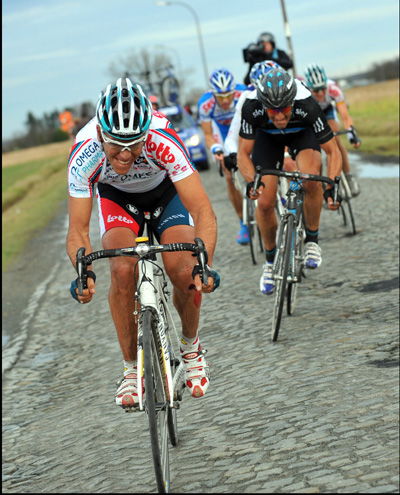Het Nieuwsblad: The season starts here
Forget the phoney battles that have been raging in Australia, the Middle East and the Mediterranean, the real cycling season starts on Saturday, at Het Nieuwsblad. But beware of drawing too many conclusions from the result.
Words by Lionel Birnie

Unless there's a huge surprise, it's a safe bet to say that whoever wins Het Nieuwsblad on Saturday will be catapulted up the list of favourites for the Tour of Flanders.
But history tells us that the big hitters prefer to save themselves for the bigger races to come in April.
People in Flanders know this. After Philippe Gilbert's second, and most impressive win, in Française des Jeux colours in 2008, I suggested to the barman in our hotel that it automatically made Pip a favourite for the Tour of Flanders.
He shook his head and made that dismissive low rumbling noise Flandrians make -– the equivalent of a motor mechanic sucking the air in through his teeth while totting up just how much it's going to cost to fix your car – then said: "Not this year. No one ever wins De Omloop and De Ronde in the same year."
And it's true. No one has ever won Het Nieuwsblad (or Het Volk as it used to be known) and then gone on to win the Tour of Flanders six weeks later.
The latest race content, interviews, features, reviews and expert buying guides, direct to your inbox!
Why is this?

Apart from the obvious facts that both races are highly competitive and hard to win, it's because six weeks is a long time to hold peak form and the favourites for the Tour of Flanders and Paris-Roubaix will time their peak for that highly-specialised week. They are likely to be good in late February but they won't necessarily be.
Take Fabian Cancellara, and Heinrich Haussler. They want to be in flying form in early April and are set to be absent from the start line in Ghent on Saturday. Tom Boonen will be there but he's already playing down expectations because he knows that there are more important races to come. Gilbert, the two-time Omloop winner, has started the season pretty well, winning a stage at the Tour of the Algarve but victory on Saturday could be seen as the kiss of death for his Flanders hopes.
In recent years, winning in Ghent has made for a disappointing return to the Tour of Flanders. Last year, Juan Antonio Flecha was in blistering form in February and March but his light had dimmed by April (34th at the Tour of Flanders).
All that said, Het Nieuwsblad is still a magical event. After all the tentative jousting in Adelaide, Doha, Muscat and along the Mediterranean, the race marks the real start of the season.
This year will be no different. It is tempting to think of Het Nieuwsblad as the Tour of Flanders Lite but it's a fiercely competitive race. There is an assumption that the top pro races get off to a steady start but that is rarely the case. Usually there's a frantic scramble to get in the first break that sticks. The attacks usually begin once they've left the neutralised zone and the flag has dropped. It'll often be riders from the smaller Belgian teams who hope to get away and stay clear long enough to get on TV.
Because the early part of even the big races are not televised, there is a belief that they start in a nice, leisurely fashion but frequently it's quite the opposite. At one edition of Het Volk, they started so quickly that we reached our usual first vantage point near Zottegem expecting to have time for a coffee, as we usually do, to find the riders were just moments away.
Only once the break is established do things let up a bit. The bunch will let them go and the break will settle into a nice rhythm. The steady progress of break and peloton belie the fierce fighting that will have gone on in the first hour.
This year there nine climbs, three fewer than last year, but it's possible the race will be more difficult.

And that is because of a two-kilometre stretch of cobbles at Haaghoek that the riders will tackle three times as they cover a loop that sits between Brakel and Oudenaarde.
They hit Haaghoek for the first time just before Tenbosse, the little suburban street that juts up off the main road into Brakel. At Geraardsbergen they skip the Muur and climb the lesser-known smooth Guilleminlaan hill instead. Then they cross the Eikenmolen and hit the Haaghoek cobbles again before the climbs come thick and fast, roughly averaging a hill every eight kilometres.
Although the run for home is familiar, with three tricky stretches of cobbles, Lippenhovenstraat (1,300m), Lange Munte (2,500m) and Steenakker (700m), it could be that the damage is done earlier.
And if you are spectating – particularly if you are heading there with a bicycle, you could do worse than to use the Haaghoek cobbles as your base, see them there three times and venture out as far as you can between each passage of the cobbles.
Whether you're heading to Belgium for the weekend or watching on a shaky internet feed, there can be no doubt that the season starts here.
Follow us on Twitter: www.twitter.com/cyclesportmag
Edward Pickering is a writer and journalist, editor of Pro Cycling and previous deputy editor of Cycle Sport. As well as contributing to Cycling Weekly, he has also written for the likes of the New York Times. His book, The Race Against Time, saw him shortlisted for Best New Writer at the British Sports Book Awards. A self-confessed 'fair weather cyclist', Pickering also enjoys running.